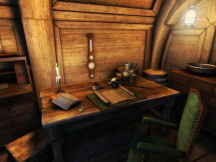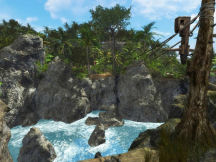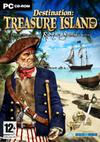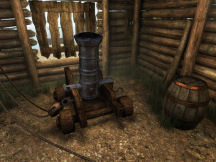“Fifteen men on the dead man’s
chest--
Yo-ho-ho and a bottle of rum!
Drink and the devil had done for the rest--
Yo-ho-ho, and a bottle of rum! (Sea shanty from Treasure Island by R.L.
Stevenson)
The mystique of swashbuckling pirates who sail to exotic
locales and smoke-blackened treasure maps that promise untold riches
captured the public imagination in an 1883 novel by Robert Louis
Stevenson. That novel was Treasure Island. It’s about Jim Hawkins,
a young boy who is thrust into the pirate life through the vagaries of
fate -- and survives through the compassion of Long John Silver, a one
legged pirate with a parrot often perched on his shoulder. I won’t take
the time to delve into the story’s moral ambiguities and coming of age for
Hawkins. The pertinent issue is that at the end of Treasure Island
three pirates were left marooned on an island, Silver has sailed off into
the horizon with some of the treasure, and Hawkins has been left to grow
into a man in ordinary fashion.
The game:
“We were schooner-rigged and rakish, with a long and
lissome hull,
And we flew the pretty colors of the crossbones and the skull;
We’d a big black Jolly Roger flapping grimly at the fore,
And we sailed the Spanish water in the happy days of yore” (From ‘A Ballad
of John Silver’ by John Masefield)
The game Destination: Treasure Island begins four
years after the novel has ended. Hawkins is now the captain of the
schooner Hispaniola, and he is locked in his cabin by bloodthirsty
pirates. It is clear they are intending to settle their score with him for
marooning them on that desolate island. Suddenly, Long John Silver’s
parrot appears in the window with a message from the old pirate -- a
treasure map, no less. That, along with his other rather pressing
circumstances, compel Hawkins to escape his ship. With his lifeboat
wrecked upon the shore of the exotically beautiful Emerald Isle, Hawkins
sets off to follow the enigmatic clues on his quest for the buried
treasure.
It was with some trepidation that I ordered this game,
for there was next to no press ballyhoo, and it suddenly appeared for
purchase one day. I wondered if the publishers were trying to sell the
game quickly, before the reviews lambasted it. Thankfully, my fears were
put to rest in short order. While neither innovative nor upper echelon,
the game is fun to play.
From a first person perspective as Hawkins, you
interpret the clues of the enigma and wander about via 360 degree panning,
gathering inventory items for use to solve puzzles and to make your way
across the island. If you are familiar with Kheops’ previous game
Return to Mysterious Island, the concept of the inventory as vital to
game play is much the same. Inventory items can and often must be taken
apart and the pieces reassembled to make other items to help you in your
progress.
Puzzles:
“Set a flame a-dancing in the dead man’s eyes”
(Destination: Treasure Island)
Puzzles are straightforward and basic. They are almost
all inventory based with some minor logic required on a few occasions.
Significantly, there is no pixel hunting and items are in plain sight.
Logic can generally be bypassed by trial and error. There are times when
you must learn to make a specific type of knot utilizing a pop-up screen.
This is interesting, but again it can be completed easily by trial and
error. There are no sliders, no mazes, no sound puzzles and only one
puzzle where the elements are color-significant. In a departure from the
abovementioned Mysterious Island, there are no action or timed
sequences, you cannot die, nor are there any “arcade” type sequences.
There is no accumulated scoring procedure as in Mysterious Island
either. In fact, you will probably find this game to be one of the easiest
games you have played in the recent past or maybe ever. But that is not
necessarily a bad thing, is it?
There is a gentle caress to having a game that you can
recommend to a novice player with an easy learning curve and additional
help throughout the game. Should you become confused about what you are
trying to accomplish at some point, you can click on the objective button
for a reminder. Clicking on inventory items is descriptive and sometimes
indicates what should be done to combine them with some other item. Even
the raspy voiced parrot will help with some clues when asked!
In addition, there is a map that allows you to
quick-move to locations you have discovered. Although sometimes a bit too
linear, even with its simplicity Destination: Treasure Island is
still a good play for seasoned adventure game players, for it has a good
story plot and it is fun to unravel the clues. Due to the ease of play the
game is rather short, but at least there is nothing artificially forced
into the game play to make it appear longer.
Visuals and Sound:
“Come men,
can’t any of you sing? Sing now, and raise the dead.” (Herman Melville)
This is where it becomes obvious that Kheops is working
on a limited budget. The art runs the gamut from a lovely island full of
precisely detailed flora and fauna, elaborate stone work, blue skies and
frothy white clouds -- to awkward-appearing water effects and strange
facial art for the characters. The use of shading is nice. On the other
hand, since Hawkins has wrecked his lifeboat on this isle, there should be
a little wind. Yet the plants and trees are as still as a postcard.
The animations are limited. This becomes glaringly
obvious when you would expect a scene with action, and are instead given a
montage of comic styled pictures to show what has occurred. This
constantly reminded me that it was a game, when I would have much
preferred living in the story. These montages, the beginning and ending
animations, and the music score are available in the gallery section of
the menu once they have been accessed in the game.
There is not much dialog in the game, but when it occurs
it does so via a pop-up screen with a picture of the character speaking.
The voices are passable.
It is also jolting when you actually do see an animation
after usually being subjected to the montages. In one scene, two
characters respond to assist you with a puzzle -- seeing them move was
like viewing a five-year-old wearing mascara.
The musical score is a rousing orchestral group of
tunes, changing as various locations are visited. The main theme is
catchy. The additional lyrics to the Deadman’s Chest song are enjoyable.
(Just stop that parrot from singing again.)
One can only wonder what these talented developers could
do with more financial backing, for their games are full of fun, and it is
clear they make them with integrity and a love for the adventure genre and
simply fall short when special effects would enhance the product.
Odds and Ends:
“Under the wide and starry sky,
Dig the grave and let me lie.
Glad did I live and gladly die,
And I laid me down with a will.
This be the verse you grave for me:
Here he lies where he longed to be;
Home is the sailor, home from the sea,
And the hunter home from the hill” (Robert Louis Stevenson,
his self-written epitaph))
The game has two disks, and it is necessary for the
second disk to be in the computer drive to play.
The game installed easily, and I encountered no glitches
or bugs.
It is alt/tab friendly.
You can save as much as you like by date; you cannot
name your saves. The game will save the progress of five players at the
same time.
Historical note: the game purports to use the Mayan 260
day (Tzolkin) calendar in a puzzle, but the glyphs are completely
inaccurate. It is pictured on a wheel, which the Mayans did not have.
Emeralds were also not of the Maya; rather they had jade and obsidian. But
no matter, it is a game and the developers can take poetic license.
This is a low pressure game where you can just admire
that (almost) deserted island, and continue following that treasure map
with glee as you wish.
Grade: B
March 2007
design copyright ©
2007
GameBoomers
Group




